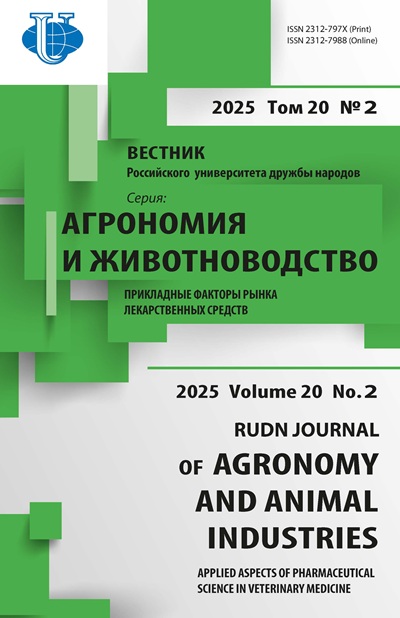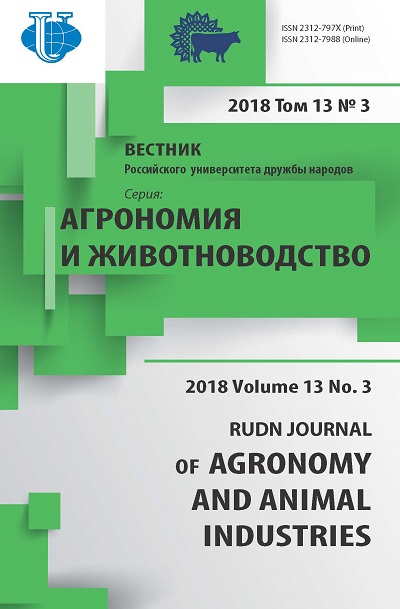WATER-SAVING IRRIGATION REGIMES FOR VEGETABLE CROP PRODUCTION UNDER CONDITIONS OF VOLGA-DON INTERFLUVE
- Authors: Nagornyy V.D.1, Kamssou K.1, Lyashko M.U.1
-
Affiliations:
- Scientific Research Institute of Design “Vid Project”
- Issue: Vol 13, No 3 (2018)
- Pages: 241-249
- Section: Agricultural technologies and land reclamation
- URL: https://agrojournal.rudn.ru/agronomy/article/view/19323
- DOI: https://doi.org/10.22363/2312-797X-2018-13-3-241-249
- ID: 19323
Cite item
Full Text
Abstract
About the authors
Victor Dmitrievich Nagornyy
Scientific Research Institute of Design “Vid Project”
Author for correspondence.
Email: nagvic@yandex.ru
Doctor of Agricultural Science, professor, Scientific Research Institute of Design “Vid Project” 1/2, Vidnoe, 142701, Russian Federation
Koi Kamssou
Scientific Research Institute of Design “Vid Project”
Email: kamssou85@gmail.com
associated Scientific Research Institute of Design “Vid Project” 1/2, Vidnoe, 142701, Russian Federation
Marina Ustimovna Lyashko
Scientific Research Institute of Design “Vid Project”
Email: lyashko.mar@yandex.ru
Candidate of Biological Science Scientific Research Institute of Design “Vid Project” 1/2, Vidnoe, 142701, Russian Federation
References
- Khaleghpanah A.N., Roozitalab B.M.H., Majdabadi A.A., Mirkhani A.R. The adsorption of Strontium on soils developed in arid region as influenced by clay content and soluble cations. In: 19th World Congress of Soil Science. 2010.
- Klikh L.V., Tupitskaya O.N., Kurbatova I.N. Methods of reducing Strontium accumulation in animals. Ukrainian Journal of Ecology. 2013;9(3):150-162. (In Ukr).
- Litvinovich A.V., Lavrishchev A.V. Strontium in the system: fertilizers (meliorants)-soils-water-plants-animals (humans). Eurasian Soil Science. 2008;(5):73-86. (In Russ).
- Nagornyy V.D. Soil and Plant Analysis. Moscow: RUDN Publ., 2013. 140 p. Henning A. Rus. Ed.: Mineral'nye veshchestva, vitaminy, biostimulyatory v kormlenii sel'skokhozyaistvennykh zhivotnykh [Mineral substances, vitamins and biopromoters in animal nutrition]. Moscow: Koloss Publ.; 1976. 559 p. (In Russ).
- Petrenko V.M. Vliyanie proizvodstva fosfornykh udobrenii na soderzhanie strontsiya v landshaftakh [Influence of phosphate fertilizers on strontium content in landscape]. [Dissertation]. 2008. 158 p. (in Russ).
- Fomichev Y.P. Some aspects of ecologically-safe production of animal products and environmental protection. Agrarian Russia. 2000;(5):5-11. (In Russ).
- Henning A. Rus. Ed.: Mineral'nye veshchestva, vitaminy, biostimulyatory v kormlenii sel'skokhozyaistvennykh zhivotnykh [Mineral substances, vitamins and biopromoters in animal nutrition]. Moscow: Koloss Publ.; 1976. 559 p. (In Russ).
- Kowalsky V.V., Zasorina E.F. To biochemistry of strontium. Eurasian Soil Science. 1965;(4): 78-88. (In Russ).
- Bowen H.J.M., Dymond J.A. Strontium and barium in plants and soils. Proc. R. Soc. Lond. B. 1955;916(144):355-368.
- Kowalsky V.V. Trudy Biogeokhimicheskoi laboratorii. Strontsievo-kal'tsievye subregiony biosfery i biogeokhimicheskie provintsii [Works of Biochemical Laboratory. Sr-Ca subregions of biosphere and biogeochemical provinces]. Moscow: Nauka Publ., 1978. 122 p. (in Russ).
- Seeprasert P., Yoneda M., Shimada Y. The Influence of Soil Fungi on Sorption of Cesium and Strontium in Soil Organic Layer. Intern. Journal of Environmental Science and Development. 2016;7(6):415-419.
- Voschenko A.V., Chugaev V.N., Ustinova E.E. Mikroelementy v biologii i ikh primenenie v sel'skom khozyaistve i meditsine [Microelements in biology and its use in crop production and medicine]. Samarkand; 1990. p.428-429 (in Russ).
- Voschenko A.V., Smekalov V.P. Urovskaya (Kashina-Beka) bolezn'. In: Malaya entsiklopediya Zabaikal'ya: Zdravookhranenie i meditsina. Novosibirsk: Nauka Publ.; 2001. 630 p. (in Russ).
- Britton K., Grimes V., Niven L., Steele T.E., McPherron S., Soressi M., Richards M.P. Strontium isotope evidence for migration in late Pleistocene Rangifer: Implications for Neanderthal hunting strategies at the Middle Palaeolithic site of Jonzac, France. Journal of Human Evolution. 2011;61(2):176-185.
- Khudyaev S.A. Strontsii v komponentakh landshaftov yuga Ob'-Irtyshskogo mezhdurech'ya [Strontium content in landscapes of Obb-Irtysh region]. [Dissertation], Novosibirsk; 2008. 130 p. (In Russ).
- Prokhorov V.M., Frid A.S. Influence of humus on speed of Srtrontium (90Sr) diffusion in quarts sand. Eurasian Soil Science. 1966;(3):67-70 (in Russ).
- Twining J., Shotton P., Tagami K., Payne T., Itakura T., Russell R., Wong H. Transfer of radioactive cesium, strontium and zinc from soil to sorghum and mung beans under field conditions in tropical Northern Australia. Classification of soil systems on the basis of transfer factors of radionuclides from soil to reference plants. 2006. P. 21.
Supplementary files















